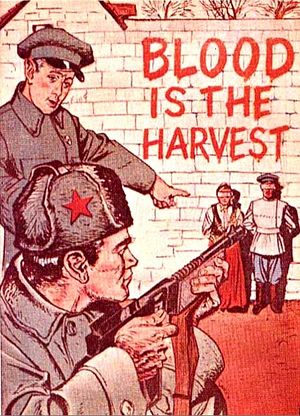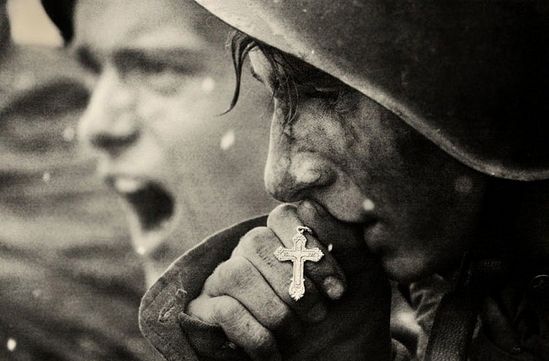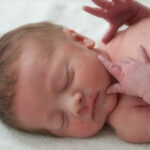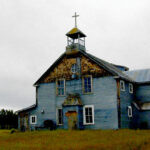Blog Post
In history’s bloodiest persecution of Christians, the Russian Communists murder millions
This is the third essay in my series on the history of Christianity in Russia. The first was the Bloody Baptism of Russia, covering the legendary arrival of the Apostle Andrew to the Mongol Invasion. The second covered the Mongol Yoke to the Bolshevik barbarians. This essay examines the Great Soviet Persecutions from the Revolution to the collapse of the Soviet Union.
By Jonathon Van Maren
As I headed across the cobblestone courtyard past the Sretensky Monastery towards the towering cathedral with glittering golden spires fiery and aglow in the morning sun, I couldn’t help but notice something: There were hundreds of people—many of them young people—streaming into the church. Inside the sanctuary, nearly a thousand people stood facing the priest for a service that lasted well over three hours—there was a bench along the back wall for the elderly, but most of them were far too tough to use it. I looked at it longingly about halfway through the service and got a scornful look from a wizened babushka in response.
Most of the women and girls stood on the right, and most of the men and boys stood on the left. The girls had brightly colored shawls—red, pink, blue—rosy cheeks, and shining eyes. As incense rose towards the dome and mingled with tendrils of smoke from the candles and the bearded priest’s deep voice melted into the baritones of the singers on high-placed balconies, glances shot back and forth between the girls on the right and the boys on the left, with shy smiles and nonverbal conversations exchanged. One teenage girl slipped out to meet a gangly boy in the staircase next to the sanctuary entrance, where they huddled smiling at each other with big eyes and squeezing each other’s hands until their knuckles whitened. They slipped back in before the service ended.
Those who forget just how recent the Soviet war on the churches was will not find anything exceptional about a church in the heart of Moscow packed with people on a Sunday morning. But to simply read the name of the cathedral is to be reminded: Consecrated on May 25, 2017 by Patriarch Kirill with Vladimir Putin in attendance, it is called the Church of the Resurrection of Christ and the New Martyrs and Confessors of the Russian Church. Services are presided over each Sunday by Bishop Tikhon, the man rumored to be Putin’s confessor, who helped design the church to commemorate the martyrs. The “new martyrs,” of course, are those butchered by the Bolsheviks. The church stands on the place once inhabited by a KGB headquarters where Christians and clergy were murdered.
There is still a little church from the 14nth century on the premises, as well. A little nun points us to where the iconography got painted over by the KGB, and the claw marks disfiguring the artwork. “Their hatred of Christianity and the Russian Orthodox Church was filled with rage,” she said. “Those who saw it said that the fervor reminded themselves of Dostoyevsky’s Demons.” Earlier in the week, as a friend and I ate a late supper with a historian, a filmmaker, and a journalist at the dining hall where the paperwork to end the Cold War was signed, the historian described her journeys through ruined monasteries and convents, churches with caved-in roofs, and the frenzied destruction of the artwork—paintings cut to ribbons, with sad shreds hanging from them. Similar things were done to the people.
The Bolshevik Revolution of 1917 brought to power men who hated God and Christianity in all its forms. Lenin, who would end up being embalmed and put on display like a dead pope after his premature passing, once called the idea of God an “unutterable vileness.” The Russian Orthodox Church, as the chief repository of tradition and culture in Holy Mother Russia, had to be extinguished in order for the godless Soviet Union to rise from the ashes. The revolutionaries got to work as soon as they could—over 12,000 clergy were murdered outright–shot, beaten to death, hanged or drowned—and a secret 1930 police report put the number of Orthodox clergy who had died in prison camps at 42,800.
One day after taking power, the Communists passed their Decree on Land, seizing all church property and buildings on October 26, 1917. The following month, church weddings were declared invalid, along with the registration of births and funerals. In January of 1918, the Church was forced out of all the schools, and the state formally severed ties. The same month, Patriarch Tikhon pushed back, declaring the Bolsheviks anathema: “Recover your senses, madmen. Bring an end to your bloody strife. You are not merely committing the deeds of Satan, which are condemning you to Gehenna in the next world, and leave a dreadful curse upon your descendants in the present one.” The Bolsheviks responded by putting him under house arrest and ramping up their assaults—while condemnation from a despised clergyman didn’t bother them, his call to the faithful had the potential to interfere with their plans: “keep away from such monsters…The enemies of the church are trying to gain power over it and seize its property by the force of guns: resist them with the strength of your faith and join your voices in a powerful clamor of protest.”
 The Bolsheviks went straight to work to silence those voices. John Kochurov, an arch-priest in St. Petersburg, was murdered on October 31. Metropolitan Vladimir of Kiev was strangled with the chain of his pectoral cross. Together with the cautionary killings of Tsar Nicholas II, his wife, the crown prince, and his four beautiful daughters in the basement of the house where they were imprisoned, it was a crimson beginning to a rising red sea of blood. As Ted Byfield noted in his High Tide and the Turn, Metropolitan Hilarion described the carnage: “Clergymen were murdered with particular brutality. They were buried alive, had cold water poured over them in sub-zero temperatures until they froze, were placed in boiling water, crucified, whipped to death and chopped with axes. Many were tortured before their deaths, or murdered along with their families or in the presence of their wives and children.”
The Bolsheviks went straight to work to silence those voices. John Kochurov, an arch-priest in St. Petersburg, was murdered on October 31. Metropolitan Vladimir of Kiev was strangled with the chain of his pectoral cross. Together with the cautionary killings of Tsar Nicholas II, his wife, the crown prince, and his four beautiful daughters in the basement of the house where they were imprisoned, it was a crimson beginning to a rising red sea of blood. As Ted Byfield noted in his High Tide and the Turn, Metropolitan Hilarion described the carnage: “Clergymen were murdered with particular brutality. They were buried alive, had cold water poured over them in sub-zero temperatures until they froze, were placed in boiling water, crucified, whipped to death and chopped with axes. Many were tortured before their deaths, or murdered along with their families or in the presence of their wives and children.”
The churches were blown up, vandalized, and smashed–many broken churches still dot the Russian countryside today. Occasional instances of outraged resistance by the faithful were often effective—at the time, the Bolsheviks preferred not to turn the people against them by opening fire. They first needed to solidify their position politically—they were already outlawing religious observance, a law that was met by another wave of defiant martyrs. Their defiance was met with force—they were shot, stabbed, and one clergyman was flung up into the air onto bayonets. In 1918 and 1919, a minimum of 28 bishops were executed along with thousands upon thousands of clergymen and laypeople.
It was not just the Russian Orthodox, either. The Bolsheviks despised all forms of Christianity, and Mennonite, Catholic, and Lutheran settlements also came under attack. Occasionally, they even banded together to fend off the marauders—for a time, lawlessness reigned, and it was open season on Christians. Interestingly, many of North America’s large and thriving Mennonite communities were originally Russian exiles fleeing this persecution—the Mennonite Central Committee (their MCC thrift stores are common sights across Canada) actually emerged from efforts to rescue their persecuted co-religionists.
The Communists pressed on, and in February of 1922 the Soviet government demanded that the Orthodox Church turn over all ecclesiastical art and artifacts. Resigned, Tikhon agreed to turn over everything except for the vessels that were used during the Liturgy. Lenin pounced on this refusal, using his control of the press to tell the Russian people that the Church was hoarding wealth while they starved in famine, and confiscating church treasures while gunning down those who resisted. The famine raging across Russia, Lenin said privately, was the perfect opportunity to break the hold of Russian Orthodoxy on the hearts and minds of the people: “We must now wage the most resolute and merciless war against the Black Hundred clergymen and crush their resistance with such brutality that they will not forget about it for several decades.”
In order to draw attention to this “merciless war,” show trials for clergy and laypeople who the Soviets claimed had resisted their confiscation orders were held, with some trials featuring more than a hundred accused at a single trial. The verdicts were a foregone conclusion, with executions happening nearly immediately after the sham trials were completed. Two thirds of Russia’s 1,025 monasteries were closed, and the Bolsheviks hastened to assure everyone that it was not only Christianity they opposed, but all forms of religion.
Initially, they permitted a few public debates between Christians and atheists—the most skilled debater for the Christian side being an evangelical Protestant professor named V.S. Martsinkovsky—but they shut them down once it became apparent that these debates had the potential to backfire. Martsinkovsky was arrested and sent into exile in 1922 because of his ability to persuade people of the truth of Christianity, and the authorities informed him that he would be allowed to return once people were wise enough to see through his lies. He was, of course, never allowed to return.
The wave of terror unleashed by the Bolsheviks was unprecedented in scale and viciousness. Archbishop Adronik of Perm was forced to dig his own grave, and then shot. Bishop Germogen of Tobolsk was lashed to the paddle wheel of an enormous steamboat and twisted to death by the blades. The Communists also established their first major concentration camp in the Solovki Islands, a former Orthodox Monastery which they ominously redubbed the Camp of Special Purpose (“the House of Special Purpose” had been the place where the Tsar and his family were kept before being executed.) Between 1917 and 1935, over 130,000 Orthodox priests were arrested, and 95,000 of them were shot by execution squads. More than 8,000 were murdered in the initial skirmishes over church treasures.
Underground churches began to form in response to the Communist persecutions, and the Bolsheviks were forced to confront an unexpected problem: Religion refused to die. Rather than vanishing in the face of Marxist enlightenment, people instead clung to their faith and traditions. Lenin decided that aggressively secular education was one answer to the problem, one that featured atheist heroes instead of the Orthodox champions of Russia’s past. Wandering through a Moscow market filled with everything from piles of wolf pelts to decommissioned landmines and hand grenades and mountains of old Communist propaganda, I found the little medals that were given to schoolchildren to fill this need for atheist heroes—they featured a chubby-cheeked baby Lenin, the ultimate children’s hero. In 1925, education that condemned religion was implemented into the school system, the only delay being a lack of available atheist teachers.
Then the Russian Orthodox Church tore itself apart. In an ill-fated move designed to keep the Church from being completely destroyed by the Communists, Metropolitan Sergius issued a declaration in 1927, two years after the death of the brave Tikhon, stating that the Soviets had authority over the church, promising his cooperation, and forbidding political dissent within the Russian Orthodox Church. Instead of ensuring the survival of the Orthodox Church as he had intended, the result was schism—the Russian Orthodox Church Outside of Russia cut ties with Moscow, and within the country the Russian Catacomb Church claimed to be the true Orthodox Church. The Bolsheviks tried to heal the rift—they now had agents in the Russian Orthodox Church and wanted to consolidate the faithful in order to make wielding control more convenient—but to no avail. Some debates on the legitimacy of succession within the Russian Orthodox Church continue to this day.
Campaigns to drive people away from church continued alongside all of this, with the aptly-named League of the Militant Godless under Yemelyan Yaroslavsky performing blasphemous parades and grotesque public mockeries of Christian ceremonies. The lesser known “five -year plan” of Joseph Stalin was his “five-year plans of atheism,” in which he attempted to have all religious influence in the Soviet Union wiped out between 1932 and 1937. Between 1937 and 1938, bloody purges resulted in the arrests of 168,300 Russian Orthodox clergymen—at least 100,000 of those arrested were shot. It was these martyrs that the gleaming new cathedral in Moscow was dedicated to on a sunny day last year, nearly a century after their demise. By the Soviets’ own calculations, at least a third of city-dwellers and two-thirds of the rural population still held religious beliefs in 1937 when the purges began. But considering the deep-rooted Christian culture that had dominated every facet of Russian life on the eve of the Bolshevik Revolution, this was a victory—although a costly victory attained by their willingness to transform clergy into corpses.
It became clear that religious sentiment had not completely disappeared with the coming of the Second World War, known to the Russians as the Great Patriotic War. Stalin was forced to call off his anti-religious campaigns in order to rally the support of the people, and he even allowed some of the churches to re-open and disbanded the League of the Militant Godless (which would be effectively replaced in 1947 by the All-Union Society of Political and Scientific Knowledge). In a truly vile turn of hypocrisy, Stalin attempted to resuscitate a servile shell of the Russian Orthodox Church in order to present the Soviet Union as defending Christian civilization against the Nazi devils.
Under the watchful eye of the KGB, the Russian Orthodox Church elected a new patriarch, opened new theological schools, and re-opened shuttered churches. Some of the clergymen who had survived their time in the prison camps were even allowed to return, although many more were not. In the meantime, clergymen presiding in territory retaken by the Red Army were promptly sent off to concentration camps on trumped-up charges to take the place of their released brethren. Stalin’s new toleration did not extend to Russian Baptists, who were viewed with suspicion due to their foreign ties.
It was Nikita Khrushchev who struck back in a campaign lasting from 1959 to 1964, shutting down 15,000 churches, nearly all seminaries, monasteries, and convents, and imprisoning any clergy who dared to voice criticism of atheism. Parents were forbidden to teach religion to their children or take their children to church, a ban which was first applied to the Russian Baptists and then expanded to the Orthodox several years later. Atheist teachers frequently beat children who professed Christian beliefs. Ironically, renewed religious persecution was even promoted as part of De-Stalinization—Stalin’s increased tolerance for the role of churches, which came only due to the pressures of an existential war, was portrayed as a betrayal of the anti-religious work begun by Lenin.
In addition to shows of brute force, the state even sent out “atheist tutors” to the homes of believers like secular Jehovah’s Witnesses to convince them to convert to atheism. Successful reversions were broadcast far and wide—stubborn believers were ostracized and harassed. These campaigns took place spasmodically throughout the 1970s as well, whenever the government became concerned that atheism was on the decline or churches were getting stronger. Clergy could be arrested and sent to the gulag simply for living lives of such charity that people were attracted to Christianity—if one was to publicly profess faith, the Soviets need them to be corrupt so they could highlight the hypocrisy.
It is difficult for us to imagine what it must have been like for those who tried to cling to faith during the long decades between the Bolshevik Revolution and the slow crumbling of the Soviet Empire. The Russian Orthodox Church in its public form existed at the whim of the Communists, who had thoroughly infiltrated much of the church hierarchy—many ecclesiastical appointments had to be approved by the same KGB that was busily murdering the faithful. Anti-religious propaganda was everywhere, and those who refused to profess atheism were fired from their jobs, harassed by authorities, subject to random arrests, and could even have their children taken from them. The state at every level was designed to douse any flicker of faith, to reward apostasy, and to punish any expression of belief. And yet, churches survived everywhere—despite the fact that millions of men, women and children who called themselves Christian were murdered in cold blood.
It was not until 1988 that a pivotal event signalling the end of Soviet persecution of Christians came, when the government decided that the millennial anniversary of the Baptism of Russia, that legendary event where St. Vladimir along with his men and the people of Kiev converted to Orthodoxy en masse, could be celebrated openly by the Russian Orthodox Church as well as the Russian people. That people would be allowed to openly celebrate an event that would have placed a target on their backs only a few short years before was enormously symbolic. The Berlin Wall would be torn down the following year, with the collapse of the Soviet Union following shortly thereafter. The godless empire exited history not with a bang, but a whimper. Slowly but surely, underground churches began to cautiously resurface, and the Russian Orthodox Church began to reassert itself.
And just as Russia emerged from her soulless experience with enforced godlessness and unmitigated murder, the West began to adopt many of the philosophies that had eliminated parental rights, forced churches underground, and launched atheism as a state religion. That stunning role reversal, some experts say, is contributing to the current tensions between Russia and the West that are currently gripping the globe. Today more than ever, understanding this history may be the key to understanding the future.
______________________________________________________
For anyone interested, my books: The Culture War, Seeing is Believing: Why Our Culture Must Face the Victims of Abortion, and How To Discuss Assisted Suicide, are available for sale here.









Bishop Fulton Sheen, in a 1950’s TV program, praised the Russian people and predicted the return of Orthodox Christianity to Russia. https://youtu.be/eRohs0AY6-4 and, in our time, Iben Thranholm, a Catholic Danish journalist confirms the resurgence of Christianity in Russia. https://youtu.be/IH7oM9kIqa8 From Canada.
I was traveling with Iben in Russia in March.
You can’t reason with Marxist Liberals today who are not motivated by reason by rather by their emotional religion of HATE. The LEFT is dominated by people who hate God, Jesus and America, the same people who created communism and the Communist block of nations, the same People who had Jesus murdered and persecuted his followers. And they are true to form, their HATRED for God and Christians hasn’t diminished in over 2000 years.
It was the Pharisees and Sadducees on the Sanhedrin that were responsible for Jesus execution. There were no Marxist liberals in ancient Israel. The Pharisees were the religious authorities that were the leaders of the Jewish people in Israel. They were neither Marxist or liberal. The Sadducees were the wealthy nobility and moneychangers in charge of the temples.
Your link to “Mongol yoke to the Bolshevik Barbarians” is misdirecting to https://thebridgehead.ca/2017/06/27/what-role-does-faith-play-in-the-standoff-between-russia-and-the-west/ instead of https://thebridgehead.ca/2018/04/20/in-russia-from-the-mongol-yoke-to-the-bolshevik-barbarians/
Thank you for your work.
Feel free to delete my comments once you put the correct link in place again.
Could you guide me to some sources for the information about the priest’s massacre you provide above? Thank you.